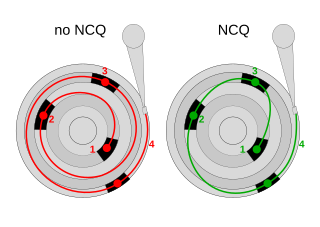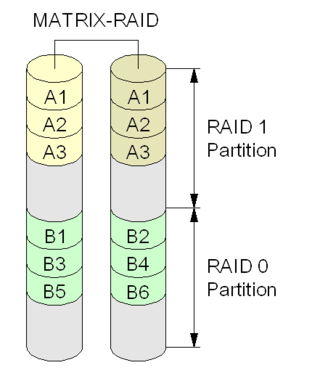Related Research Articles
RAID is a data storage virtualization technology that combines multiple physical disk drive components into one or more logical units for the purposes of data redundancy, performance improvement, or both. This is in contrast to the previous concept of highly reliable mainframe disk drives referred to as "single large expensive disk" (SLED).

DragonFly BSD is a free and open-source Unix-like operating system forked from FreeBSD 4.8. Matthew Dillon, an Amiga developer in the late 1980s and early 1990s and FreeBSD developer between 1994 and 2003, began working on DragonFly BSD in June 2003 and announced it on the FreeBSD mailing lists on 16 July 2003.
In computer storage, logical volume management or LVM provides a method of allocating space on mass-storage devices that is more flexible than conventional partitioning schemes to store volumes. In particular, a volume manager can concatenate, stripe together or otherwise combine partitions into larger virtual partitions that administrators can re-size or move, potentially without interrupting system use.

Network-attached storage (NAS) is a file-level computer data storage server connected to a computer network providing data access to a heterogeneous group of clients. The term "NAS" can refer to both the technology and systems involved, or a specialized device built for such functionality.
A disk array controller is a device that manages the physical disk drives and presents them to the computer as logical units. It almost always implements hardware RAID, thus it is sometimes referred to as RAID controller. It also often provides additional disk cache.

In computing, Native Command Queuing (NCQ) is an extension of the Serial ATA protocol allowing hard disk drives to internally optimize the order in which received read and write commands are executed. This can reduce the amount of unnecessary drive head movement, resulting in increased performance for workloads where multiple simultaneous read/write requests are outstanding, most often occurring in server-type applications.
The device mapper is a framework provided by the Linux kernel for mapping physical block devices onto higher-level virtual block devices. It forms the foundation of the logical volume manager (LVM), software RAIDs and dm-crypt disk encryption, and offers additional features such as file system snapshots.
A NetApp FAS is a computer storage product by NetApp running the ONTAP operating system; the terms ONTAP, AFF, ASA, FAS are often used as synonyms. "Filer" is also used as a synonym although this is not an official name. There are three types of FAS systems: Hybrid, All-Flash, and All SAN Array:
- NetApp proprietary custom-build hardware appliances with HDD or SSD drives called hybrid Fabric-Attached Storage
- NetApp proprietary custom-build hardware appliances with only SSD drives and optimized ONTAP for low latency called ALL-Flash FAS
- All SAN Array build on top of AFF platform, and provide only SAN-based data protocol connectivity.
Data scrubbing is an error correction technique that uses a background task to periodically inspect main memory or storage for errors, then corrects detected errors using redundant data in the form of different checksums or copies of data. Data scrubbing reduces the likelihood that single correctable errors will accumulate, leading to reduced risks of uncorrectable errors.
In computer science, storage virtualization is "the process of presenting a logical view of the physical storage resources to" a host computer system, "treating all storage media in the enterprise as a single pool of storage."
In BSD-derived computer operating systems and in related operating systems such as SunOS, a disklabel is a record stored on a data storage device such as a hard disk that contains information about the location of the partitions on the disk. Disklabels were introduced in the 4.3BSD-Tahoe release. Disklabels are usually edited using the disklabel utility. In later versions of FreeBSD, this was renamed as bsdlabel.
In computing, error recovery control (ERC) is a feature of hard disks which allow a system administrator to configure the amount of time a drive's firmware is allowed to spend recovering from a read or write error. Limiting the recovery time allows for improved error handling in hardware or software RAID environments. In some cases, there is a conflict as to whether error handling should be undertaken by the hard drive or by the RAID implementation, which leads to drives being marked as unusable and significant performance degradation, when this could otherwise have been avoided.
Although all RAID implementations differ from the specification to some extent, some companies and open-source projects have developed non-standard RAID implementations that differ substantially from the standard. Additionally, there are non-RAID drive architectures, providing configurations of multiple hard drives not referred to by RAID acronyms.
mdadm is a Linux utility used to manage and monitor software RAID devices. It is used in modern Linux distributions in place of older software RAID utilities such as raidtools2 or raidtools.
A logical disk, logical volume or virtual disk is a virtual device that provides an area of usable storage capacity on one or more physical disk drive(s) in a computer system. The disk is described as logical or virtual because it does not actually exist as a single physical entity in its own right. The goal of the logical disk is to provide computer software with what seems a contiguous storage area, sparing them the burden of dealing with the intricacies of storing files on multiple physical units. Most modern operating systems provide some form of logical volume management.
geom_raid5 is a storage module created for the FreeBSD operating system. It facilitates RAID5 functionality without the need of a hardware RAID controller.
GEOM is the main storage framework for the FreeBSD operating system. It is available in FreeBSD 5.0 and later releases, and provides a standardized way to access storage layers. GEOM is modular and allows for geom modules to connect to the framework. For example, the geom_mirror module provides RAID1 or mirroring functionality to the system. A number of modules are provided as part of FreeBSD and others have been developed independently and are distributed via (e.g.) GitHub.

Intel Rapid Storage Technology (RST) is a driver SATA AHCI and a firmware-based RAID solution built into a wide range of Intel chipsets. Currently also is installed as a driver for Intel Optane temporary storage units.
NVM Express (NVMe) or Non-Volatile Memory Host Controller Interface Specification (NVMHCIS) is an open, logical-device interface specification for accessing a computer's non-volatile storage media usually attached via the PCI Express bus. The initial NVM stands for non-volatile memory, which is often NAND flash memory that comes in several physical form factors, including solid-state drives (SSDs), PCIe add-in cards, and M.2 cards, the successor to mSATA cards. NVM Express, as a logical-device interface, has been designed to capitalize on the low latency and internal parallelism of solid-state storage devices.
The bio(4) pseudo-device driver and the bioctl(8) utility implement a generic RAID volume management interface in OpenBSD and NetBSD. The idea behind this software is similar to ifconfig, where a single utility from the operating system can be used to control any RAID controller using a generic interface, instead of having to rely on many proprietary and custom RAID management utilities specific for each given hardware RAID manufacturer. Features include monitoring of the health status of the arrays, controlling identification through blinking the LEDs and managing of sound alarms, and specifying hot spare disks. Additionally, the softraid configuration in OpenBSD is delegated to bioctl as well; whereas the initial creation of volumes and configuration of hardware RAID is left to card BIOS as non-essential after the operating system has already been booted. Interfacing between the kernel and userland is performed through the ioctl system call through the /dev/bio pseudo-device.
References
- 1 2 Greg Lehey (1999). The Vinum Volume Manager (PDF). Proceedings of the FREENIX Track: 1999 USENIX Annual Technical Conference. USENIX (published June 6–11, 1999).
- "The Vinum Volume Manager". Usnix.
- 1 2 "vinum — Logical Volume Manager control program". BSD Cross Reference. DragonFly BSD.
- "vinum - Logical Volume Manager control program". DragonFly On-Line Manual Pages.
- 1 2 "gvinum — Logical Volume Manager control program". BSD Cross Reference. FreeBSD.
- "gvinum -- Logical Volume Manager control program". FreeBSD Manual Pages.
- ↑ Christos Zoulas (2006-02-25). "CVS commit: src/sys/dev". source-changes@ (Mailing list). NetBSD.
As core requested, remove vinum
- ↑ "Announcing NetBSD 4.0". NetBSD. 2007-12-19.